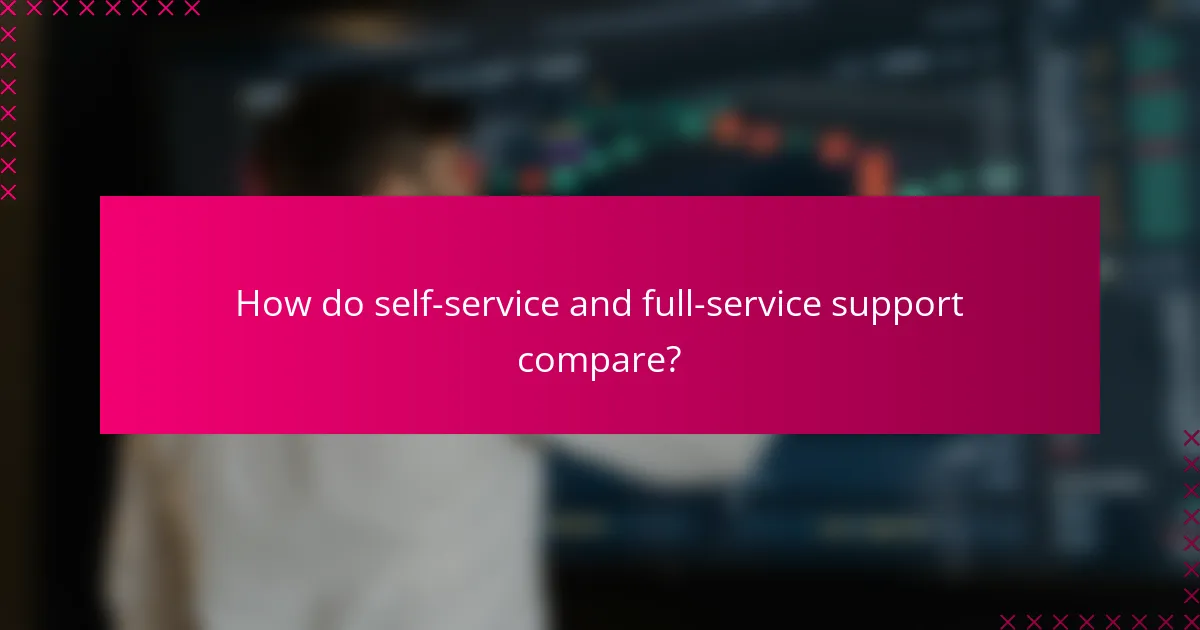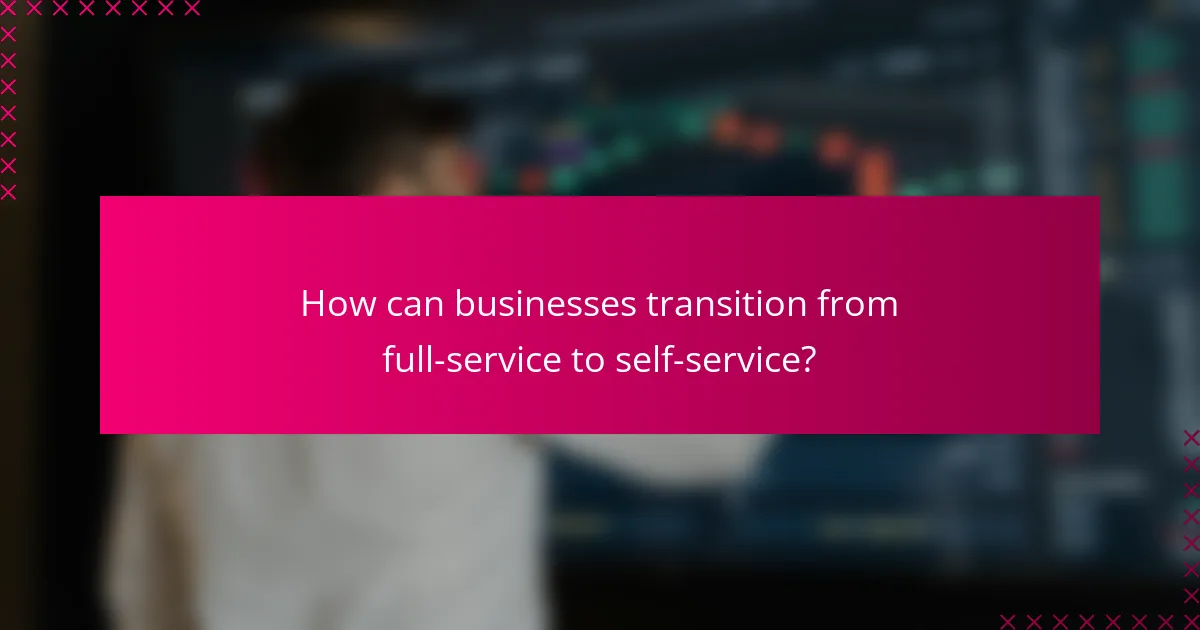Choosing between self-service and full-service support is crucial for optimizing customer satisfaction and operational efficiency. Self-service support empowers users to resolve issues independently, while full-service support offers personalized assistance for more complex problems. Understanding when to implement each approach can significantly impact resource allocation and overall customer experience.

What are the benefits of self-service support in SaaS?
Self-service support in SaaS offers users the ability to resolve issues independently, leading to increased efficiency and satisfaction. This approach allows organizations to reduce operational costs while providing immediate assistance to customers.
Cost-effectiveness
Self-service support significantly lowers costs for SaaS providers by reducing the need for extensive customer service teams. By enabling users to find solutions through FAQs, knowledge bases, and community forums, companies can allocate resources more efficiently.
For example, businesses may see a reduction in support costs by up to 30% when implementing self-service options. This savings can be redirected towards product development or marketing efforts.
24/7 availability
Self-service support ensures that users can access help anytime, regardless of time zones or business hours. This constant availability is crucial for global SaaS companies, allowing customers to resolve issues without waiting for live support.
Many self-service platforms provide instant access to resources, enabling users to troubleshoot problems in real-time. This can lead to quicker resolution times and improved user satisfaction.
Empowered users
Self-service support empowers users by giving them control over their experience. When customers can find answers independently, they feel more confident and capable, which enhances their overall satisfaction with the service.
Encouraging users to engage with self-service resources can also foster a sense of community, as they share solutions and tips with one another. This collaborative environment can lead to a more loyal customer base.

When is full-service support the better option?
Full-service support is the better option when customers face complex issues that require expert intervention or when personalized assistance is essential. This approach ensures that customers receive tailored solutions and builds stronger relationships with the service provider.
Complex issue resolution
Full-service support excels in resolving complex issues that self-service options may not adequately address. For instance, technical problems involving multiple systems or intricate configurations often require specialized knowledge that only trained professionals possess.
When dealing with such challenges, customers should consider reaching out for full-service support to avoid frustration and wasted time. It’s advisable to have detailed information about the issue ready, as this can expedite the resolution process.
Personalized assistance
Customers seeking personalized assistance benefit significantly from full-service support. This type of service allows for direct interaction with knowledgeable representatives who can provide tailored advice and solutions based on individual needs.
For example, a customer looking for a specific product recommendation or troubleshooting guidance can receive immediate, customized help. This level of support can enhance customer satisfaction and foster loyalty.
High-value customer relationships
Full-service support plays a crucial role in building high-value customer relationships. By offering dedicated assistance, companies can demonstrate their commitment to customer success, which can lead to increased trust and long-term loyalty.
To maximize these relationships, businesses should actively engage with customers, solicit feedback, and follow up on resolved issues. This proactive approach can turn one-time customers into repeat clients, ultimately benefiting the business’s bottom line.

How do self-service and full-service support compare?
Self-service support allows customers to resolve issues independently, while full-service support provides direct assistance from customer service representatives. The choice between the two depends on factors such as response time, customer satisfaction, and resource allocation.
Response times
Self-service support typically offers faster response times since customers can access information and solutions immediately through online resources. In contrast, full-service support may involve waiting for a representative, which can take anywhere from a few minutes to several hours, depending on demand and staffing levels.
For urgent issues, self-service options are often preferable, as they allow for quick resolutions without the need to wait for human intervention. However, complex problems may require full-service support, which can extend response times but ultimately lead to more thorough solutions.
Customer satisfaction rates
Customer satisfaction rates can vary significantly between self-service and full-service support. Self-service options tend to be favored by tech-savvy customers who appreciate the speed and autonomy they provide, often achieving satisfaction rates in the high 70s to low 80s percentage range.
On the other hand, full-service support can lead to higher satisfaction for customers who prefer personal interaction, especially in complicated situations. Satisfaction rates for full-service support can also reach similar levels, particularly when representatives are well-trained and responsive.
Resource allocation
Self-service support can be more cost-effective for businesses, as it reduces the need for extensive staffing and allows resources to be allocated elsewhere. Companies can invest in creating comprehensive FAQs, tutorials, and chatbots to handle common inquiries efficiently.
Full-service support requires more human resources, which can lead to higher operational costs. However, it can be justified in industries where personalized service is crucial, such as healthcare or financial services, where customer trust and relationship management are paramount.

What factors influence the choice between self-service and full-service?
The choice between self-service and full-service support is influenced by customer demographics, the type of product or service offered, and specific business model considerations. Understanding these factors can help businesses determine which support method best meets their needs and those of their customers.
Customer demographics
Customer demographics play a critical role in deciding between self-service and full-service support. Younger customers, often more tech-savvy, may prefer self-service options like FAQs and chatbots, while older customers might lean towards full-service support for personalized assistance.
Businesses should analyze their customer base to identify preferences. For instance, a company targeting millennials may benefit from a robust self-service platform, whereas a business serving seniors might prioritize full-service support to enhance customer satisfaction.
Type of product or service
The nature of the product or service significantly impacts the choice of support. Complex products, such as software or machinery, often require full-service support due to the need for detailed guidance and troubleshooting. In contrast, simpler products, like household items, may be effectively supported through self-service resources.
Consider the support needs of your offerings. For example, a tech company providing intricate software solutions should invest in full-service support, while a retailer selling basic consumer goods could focus on self-service options to streamline operations.
Business model considerations
Business models also dictate the appropriate support strategy. Companies with subscription-based models may favor self-service to reduce costs and improve efficiency, allowing customers to access help at any time. Conversely, businesses relying on high-touch sales may benefit from full-service support to foster relationships and enhance customer loyalty.
Evaluate your business model’s requirements. A SaaS company might implement self-service tutorials and forums, while a luxury brand may prioritize full-service support to maintain a premium customer experience.

What are the best practices for implementing self-service support?
Implementing self-service support effectively requires a focus on user experience, accessible information, and continuous improvement. By prioritizing these elements, organizations can enhance user satisfaction and reduce the need for full-service support.
User-friendly interfaces
A user-friendly interface is crucial for self-service support, as it directly impacts how easily users can navigate and find information. Ensure that the design is intuitive, with clear menus and search functionalities that guide users to relevant resources. Consider using visual elements like icons and tooltips to enhance usability.
Regularly test the interface with real users to identify pain points and areas for improvement. Aim for a design that minimizes clicks and provides quick access to commonly sought information, which can significantly enhance the user experience.
Comprehensive knowledge bases
A comprehensive knowledge base is essential for effective self-service support, as it serves as the primary resource for users seeking answers. This should include a wide range of topics, from FAQs to detailed guides and troubleshooting steps. Organize content logically, using categories and tags to help users find information quickly.
Regularly update the knowledge base to reflect new products, services, or changes in procedures. Encouraging user contributions, such as feedback on articles or suggestions for new topics, can also help keep the content relevant and useful.
Regular updates and feedback loops
Regular updates and feedback loops are vital for maintaining the effectiveness of self-service support. Schedule routine reviews of the knowledge base and user interface to ensure they remain current and effective. This can include updating outdated information and adding new resources based on user needs.
Implement feedback mechanisms, such as surveys or user ratings, to gather insights on the self-service experience. Use this feedback to make informed decisions about improvements, ensuring that the support system evolves in line with user expectations and technological advancements.

How can businesses transition from full-service to self-service?
Businesses can transition from full-service to self-service by evaluating their customer interactions and identifying areas where automation can enhance efficiency. This process involves implementing user-friendly platforms that empower customers to find solutions independently while ensuring support is available when needed.
Assessing customer needs
Understanding customer needs is crucial for a successful transition to self-service. Businesses should gather feedback through surveys, interviews, and usage analytics to determine which services customers prefer to handle on their own and which require personal assistance.
Consider segmenting customers based on their preferences and technical proficiency. For example, tech-savvy users may prefer self-service options, while less experienced customers might need more guidance. Tailoring services to these segments can improve overall satisfaction.
Additionally, monitor customer interactions to identify common issues and frequently asked questions. This data can inform the development of self-service resources, such as FAQs, tutorials, and chatbots, ensuring they address the most relevant concerns effectively.
